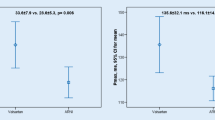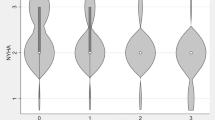Abstract
The sacubitril/valsartan combination is an important agent used in the treatment of heart failure with reduced ejection fraction (HFrEF). Pulmonary artery stiffness (PAS) is an index developed to evaluate the pulmonary vascular bed. Changes in pulmonary vascular structures in HFrEF patients can affect PAS. In this study, we aimed to investigate the effect of sacubitril/valsartan on PAS in HFrEF patients. One hundred fifty HFrEF patients, who received sacubitril/valsartan therapy and continued for at least 6 months without interruption, were examined retrospectively. N-terminal pro-B-type natriuretic peptide levels (NT-proBNP), NYHA classes, Minnesota Living with Heart Failure Questionnaire (MLWHFQ) scores, New York Heart Association (NYHA) functional classes and echocardiograpic parameters such as left ventricular ejection fraction (LVEF), mean pulmonary artery pressure (mPAP), right ventricle myocardial performance index (RV-MPI), Tricuspid annular plane systolic excursion (TAPSE), right ventricular fractional area change (RV-FAC) and PAS changes were evaluated before and 6 months after sacubitril/valsartan treatment. PAS was calculated by using the maximal frequency shift and acceleration time of the pulmonary artery flow trace measured in the echocardiogram. PAS values were significantly reduced (23.8 ± 2.8 vs 19.1 ± 3.1 kHz/ms, p < 0.001) after the sacubitril/valsartan treatment. Sacubitril/valsartan treatment was associated with significant improvements in NYHA class and MLWHFQ scores; significant reductions in the NT-proBNP levels, mPAP, and RV-MPI, and significant increases in LVEF, TAPSE, and RV-FAC (p < 0.05). The significant reduction in the PAS value was significantly correlated with the improvements in the MLWFQ scores, NT-proBNP levels, mPAP, RV-MPI, TAPSE and RV-FAC. In HFrEF patients, switching from angiotensin-converting enzyme inhibitor/angiotensin II receptor blocker therapy to sacubitril/valsartan may result in reduction in PAS.



Similar content being viewed by others
References
Ponikowski P, Voors AA, Anker SD et al (2016) ESC Guidelines for the diagnosis and treatment of acute and chronic heart failure: the Task Force for the diagnosis and treatment of acute and chronic heart failure of the European Society of Cardiology (ESC) developed with the special contribution of the Heart Failure Association (HFA) of the ESC. Eur Heart J 37:2129–2200
McMurray JJV, Packer M, Desai AS et al (2014) Angiotensin–neprilysin inhibition versus enalapril in heart failure. N Engl J Med 371:993–1004
Januzzi JL Jr, Prescott MF, Butler J et al (2019) Association of change in N-terminal pro-B-type natriuretic peptide following initiation of sacubitril–valsartan treatment with cardiac structure and function in patients with heart failure with reduced ejection fraction. JAMA 322:1–11
Khan Z, Gholkar G, Tolia S, Kado H, Zughaib M (2018) Effect of sacubitril/valsartan on cardiac filling pressures in patients with left ventricular systolic dysfunction. Int J Cardiol 271:169–173
Görgülü S, Eren M, Yildirim A et al (2003) A new echocardiographic approach in assessing pulmonary vascular bed in patients with congenital heart disease: pulmonary artery stiffness. Anadolu Kardiyol Derg 3:92–97
Yildirim E, Celik M, Yuksel UC et al (2017) Relationship between pulmonary artery stiffness and functional capacity in patients with heart failure with reduced ejection fraction. Korean Circ J 47:929–938
Duman D, Masatlioğlu S, Demirtunç R, Karadağ B (2008) Increased pulmonary artery stiffness and its relation to right ventricular function in patients with systemic lupus erythematosus. Turk Kardiyol Dern Ars 36:82–89
Rosenkranz S, Gibbs JS, Wachter R et al (2016) Left ventricular heart failure and pulmonary hypertension. Eur Heart J 37:942–954
Hulsmann M, Berger R, Sturm B et al (2002) Prediction of outcome by neurohumoral activation, the six-minute walk test and the Minnesota Living with Heart Failure Questionnaire in an outpatient cohort with congestive heart failure. Eur Heart J 11:886–891
Chemla D, Castelain V, Humbert M et al (2004) New formula for predictingmean pulmonary artery pressure using systolic pulmonary artery pressure. Chest 126:1313–1317
Mitchell C, Rahko PS, Blauwet LA et al (2019) Guidelines for performing a comprehensive transthoracic echocardiographic examination in adults: recommendations from the American Society of Echocardiography. J Am Soc Echocardiogr 32:1–64
Tozzi CA, Christiansen DL, Poiani GJ et al (1994) Excess collagen in hypertensive pulmonary arteries decreases vascular distensibility. Am J Respir Crit Care Med 149:1317–1326
Wang Z, Lakes RS, Golob M et al (2013) Changes in large pulmonary arterial viscoelasticity in chronic pulmonary hypertension. PLoS One 8:e78569
Wang Z, Lakes RS, Eickhoff JC et al (2013) Effects of collagen deposition on passive and active mechanical properties of large pulmonary arteries in hypoxic pulmonary hypertension. Biomech Model Mechanobiol 12:1115–1125
Stevens GR, Garcia-Alvarez A, Sahni S et al (2012) RV dysfunction in pulmonary hypertension is independently related to pulmonary artery stiffness. JACC Cardiovasc Imaging 5:378–387
Zoghbi WA, Habib GB, Quinones MA (1990) Doppler assessment of right ventricular filling in a normal population. Comparison with left ventricular filling dynamics. Circulation 82:1316–1324
Kang KW, Chang HJ, Kim YJ et al (2011) Cardiac magnetic resonance imaging-derived pulmonary artery distensibility index correlates with pulmonary artery stiffness and predicts functional capacity in patients with pulmonary arterial hypertension. Circ J 75:2244–2251
Nemes A, Forster T (2013) Evaluation of pulmonary artery stiffness using routine clinical imaging methods. Orv Hetil 154:1931–1933
Ozkececi G, Ulasli SS, Akci O et al (2016) Assessment of pulmonary arterial stiffness in obstructive sleep apnea. Int J Cardiovasc Imaging 32:799–805
Mahfouz RA (2012) Impact of pulmonary artery stiffness on right ventricular function and tricuspid regurgitation after successful percutaneous balloon mitral valvuloplasty: the importance of early intervention. Echocardiography 29:1157–1163
Cerik IB, Meric M, Gulel O et al (2019) Echocardiographic assessment of pulmonary arterial stiffness in human immunodeficiency virus-infected patients. Echocardiography 36:1123–1131
Gu J, Noe A, Chandra P et al (2010) Pharmacokinetics and pharmacodynamics of LCZ696, a novel dual-acting angiotensin receptor-neprilysin inhibitor (ARNi). J Clin Pharmacol 50:401–414
Desai AS, McMurray JJ, Packer M et al (2015) Effect of the angiotensin-receptor-neprilysin inhibitor LCZ696 compared with enalapril on mode of death in heart failure patients. Eur Heart J 36:1990–1997
Kang DH, Park SJ, Shin SH et al (2019) Angiotensin receptor neprilysin inhibitor for functional mitral regurgitation. Circulation 139:1354–1365
Almufleh A, Marbach J, Chih S et al (2017) Ejection fraction improvement and reverse remodeling achieved with sacubitril/valsartan in heart failure with reduced ejection fraction patients. Am J Cardiovasc Dis 108–7(113):1354–1365
Bayard G, Da Costa A, Pierrard R et al (2019) Impact of sacubitril/valsartan on echo parameters in heart failure patients with reduced ejection fraction a prospective evaluation. Int J Cardiol Heart Vasc 25:100418
Delgado JF, Conde E, Sánchez V et al (2005) Pulmonary vascular remodeling in pulmonary hypertension due to chronic heart failure. Eur J Heart Fail 7:1011–1016
Hsu JH, Liou SF, Yang SN et al (2014) B-type natriuretic peptide inhibits angiotensin II-induced proliferation and migration of pulmonary arterial smooth muscle cells. Pediatr Pulmonol 49:734–744
Clements RT, Vang A, Fernandez-Nicolas A et al (2019) Treatment of pulmonary hypertension with angiotensin II receptor blocker and neprilysin inhibitor sacubitril/valsartan. Circ Heart Fail 12:e005819
Weir-McCall JR, Struthers AD, Lipworth BJ, Houston JG et al (2015) The role of pulmonary arterial stiffness in COPD. Respir Med 109:1381–1390
Altıparmak HI, Erkus ME, Polat M et al (2016) Evaluation of pulmonary artery stiffness in patients with obstructive sleep apnea syndrome. Echocardiography 33:362–371
De Simone V, Guarise P, Zanotto G, Morando G (2019) Reduction in pulmonary artery pressures with use of sacubitril/valsartan. J Cardiol Cases 20:187–190
Masetti M, Corazza F, Giovannini L et al (2020) Hemodynamic effects of sacubitril-valsartan in heart failure with reduced-ejection fraction: are all doses created equal? J Heart Lung Transplant 39:S53
Author information
Authors and Affiliations
Corresponding author
Ethics declarations
Conflict of interest
None declared.
Additional information
Publisher's Note
Springer Nature remains neutral with regard to jurisdictional claims in published maps and institutional affiliations.
Rights and permissions
About this article
Cite this article
Yenerçağ, M., Arslan, U., Dereli, S. et al. Effects of angiotensin receptor neprilysin inhibition on pulmonary arterial stiffness in heart failure with reduced ejection fraction. Int J Cardiovasc Imaging 37, 165–173 (2021). https://doi.org/10.1007/s10554-020-01973-8
Received:
Accepted:
Published:
Issue Date:
DOI: https://doi.org/10.1007/s10554-020-01973-8




